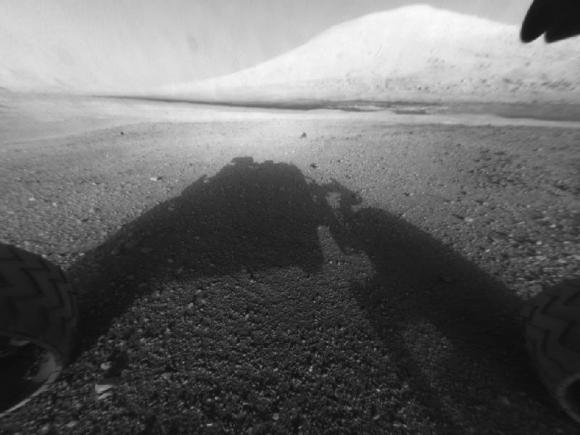The Curiosity rover has been a near constant presence in the news since it arrived on the surface of the Red Planet in August. But even with everything Curiosity has done already, its most exciting days lie ahead, says Brown University geologist Ralph Milliken.
Milliken is a participating scientist on the mission and has just returned to Brown after three months working from NASA’s Jet Propulsion Lab in Pasadena. Much of the mission thus far has been diagnostic, Milliken says — putting the rover’s mechanical parts and scientific instruments through their paces to make sure they’re all doing what they’re supposed to do. So far Curiosity is performing remarkably well, Milliken reports, and has made several interesting findings. But the science is really just getting started.

For Milliken, the most exciting part of the mission still looms well off on the Martian horizon in the imposing form of Mount Sharp. Towering three miles high from the surface of Curiosity’s Gale Crater landing site, Mount Sharp holds a 4-billion-year-old record of Martian geological history. Curiosity will head up the mountain in the coming months, and Milliken hopes the rover can play that history back like a needle on an LP. The slopes are gentle enough that Curiosity will be able to explore a substantial chunk of the mountain — perhaps more than a vertical mile of strata, Milliken hopes — before the terrain gets too steep.
The big question scientists hope Mount Sharp will answer is why Mars dried out and whether the rocks record the history of once-habitable environments. Previous missions have unveiled tantalizing clues of a warmer, wetter Martian past, and Curiosity has already confirmed that water once flowed on the Martian surface. Very early in the mission it came across what appears to be an ancient streambed. Rocks in the bed have a rounded appearance, consistent with erosion caused by ankle- to hip-deep water. But that discovery leaves lots of questions. Was flowing water on Mars a fleeting event or was it there for an extended period? And perhaps most importantly, where did that water go?
“We can see from satellite data of Mars that water-bearing minerals are at the bottom of Mount Sharp, and as you go up you don’t see them anymore,” Milliken explains. “The bottom has these channels carved by water and at the top you don’t see those anymore either. This is all consistent with the idea that the rocks in Mount Sharp preserve a history of this drying out of Mars.”
As Curiosity climbs, it will map that transition. Milliken will be working specifically with the Dynamic Albedo of Neutrons (DAN) instrument. It works by detecting the rate at which neutrons are emitted from the surface and subsurface directly under the rover. Hydrogen in water molecules slows neutrons down. So in places where neutron release is slower, scientists can infer the presence of hydrogen, and thus hydrated minerals. In addition to passively collecting natural neutron emissions, the DAN instrument can also send an active pulse of neutrons into the ground and see what bounces back.
“As we drive along, we can do these active and passive measurements to try to create a map of how the water beneath the surface is actually distributed,” Milliken said. “As we go up the mountain — as we go through time into the younger rocks — we hope to get a high-fidelity view of what’s happening with the water-bearing minerals in those rocks.”
All of this will hopefully give clues about the question Curiosity was sent to Mars to answer: Could the Gale Crater area have supported life? “Measurements from the instruments on Curiosity might be able to point us to places where we should look for evidence of life, if it existed, and places where such evidence is most likely to be preserved,” Milliken said.
Along the way, Milliken said, we may also learn fundamental things about how terrestrial planets evolve through time — things that we can’t easily learn here on Earth. On our home planet, the oldest rocks are ground away by the shifting of tectonic plates. But Mars appears to lack plate tectonics, so the planet has many rocks far older than we have on Earth.
“One of the things that excites me is you have preservation on Mars of what a terrestrial planet was like four or four-and-a-half billion years ago,” Milliken said. “You just don’t find rocks that are four-and-a-half billion years old on Earth. We have to do some guessing about what Earth was like then because we don’t have the rocks. But on Mars they’re preserved.”
So in that way, perhaps Mars is more than just our nearest neighbor in the solar system. Perhaps it’s a planetary fossil that can tell us more about how our own planet came to be.

